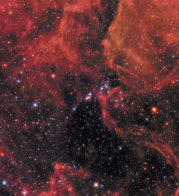
Image credit: Marc de Boer/Ori Ginale.
In the early morning of 3 December, scientists and engineers started the installation of KM3NeT (CERN Courier July/August 2012 p31). Once completed, it will be the largest detector of neutrinos in the Northern Hemisphere. Located in the depths of the Mediterranean Sea, the infrastructure will be used to study the fundamental properties of neutrinos and to map the high-energy cosmic neutrinos emanating from extreme cataclysmic events in space.
Neutrinos are the most elusive of elementary particles and their detection requires the instrumentation of enormous volumes: the KM3NeT neutrino telescope will occupy more than a cubic kilometre of seawater. It comprises a network of several hundred vertical detection strings, anchored to the seabed and kept taut by a submerged buoy. Each string hosts 18 light-sensor modules, equally spaced along its length. In the darkness of the abyss, the sensor modules register the faint flashes of Cherenkov light that signal the interaction of neutrinos with the seawater surrounding the telescope.
On board the Ambrosius Tide deployment boat, the first string – wound, like a ball of wool, around a spherical frame – arrived at the location of the KM3NeT-Italy site, south of Sicily. It was anchored to the seabed at a depth of 3500 m and connected to a junction box, already present on the sea floor, using a remotely operated submersible. The junction box is connected by a 100 km cable to the shore station located in Portopalo di Capo Passero in the south of Sicily.
After verification of the quality of the power and fibre-optic connections to the shore station, the go-ahead was given to trigger the unfurling of the string to its full 700 m height. During this process, the deployment frame is released from its anchor and floats towards the surface while slowly rotating. In doing so, the string unwinds from the spherical frame, eventually leaving behind a vertical string. The string was then powered on from the shore station, and the first data from the sensor modules started streaming to shore.
The successful acquisition of data from the abyss with the novel technology developed by the KM3NeT collaboration is a major milestone for the project. It represents the culmination of more than 10 years of research and development by the many research institutes that make up the international collaboration.





